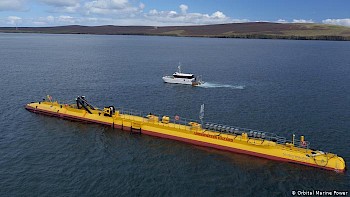Ocean energy about to ride a wave
 Though the Orkney archipelago off the northern Scottish coast is only home to about 22,000 people, it has become a global hub for harnessing a boundless renewable energy source: the ocean.
Though the Orkney archipelago off the northern Scottish coast is only home to about 22,000 people, it has become a global hub for harnessing a boundless renewable energy source: the ocean.
For two decades, Orkney’s fast-flowing tidal inlets and coastlines battered by ocean swells have been test sites for fledgling wave and tidal stream energy prototypes. More are being expanded and plugged into the UK grid.
One Scottish ocean energy company, Orbital Marine Power, has been testing tidal stream technologies that are ready to go large-scale, including a giant turbine capable of powering over 1,700 homes. With the first “O2” turbine due to be deployed this year at Orkney’s European Marine Energy Centre (EMEC), and another to follow in 2023, it is one of several commercial marine energy farms that could contribute up to a fifth of the UK’s power needs.
The long road to harnessing marine power
 Bringing a renewable energy source like ocean energy to market has, as with wind and solar, demanded extensive research and development. But tidal and wave energy lost significant momentum in the wake of the 2008 global financial crisis. “The industry kind of hit a wall,” said Ian Masters, professor of marine energy at the University of Swansea in Wales. “Those of us involved have had to reinvent ourselves.”
Bringing a renewable energy source like ocean energy to market has, as with wind and solar, demanded extensive research and development. But tidal and wave energy lost significant momentum in the wake of the 2008 global financial crisis. “The industry kind of hit a wall,” said Ian Masters, professor of marine energy at the University of Swansea in Wales. “Those of us involved have had to reinvent ourselves.”
For technical reasons, wave energy itself has proven difficult to harness. Of the countless wave generator prototypes designed and tested in the last 20 years, very few have reached commercial scale — despite much promise.
The key problem is variability. AbuBakr Bahaj, professor of sustainable energy at the UK University of Southampton and editor-in-chief of the International Marine Energy Journal, says that because waves are in constant flux and move in multiple directions and heights, devices must also be flexible and durable enough to both harness energy and handle heavy and constant motion. “It’s very difficult to capture a lot of energy,” he said.
Despite the success of the worm-like Pelamis Wave Power energy converter — the first wave-based generator worldwide to be connected to the national grid in 2004 before the project went into administration a decade later — Bahaj explains that wave energy is currently being perfected at a reduced scale to remotely power smaller coastal communities.
Tidal stream energy on the other hand is significantly more reliable. Based on the pull of the moon and earth’s rotation, tidal flows are “very predictable,” said Bahaj. “You can do a plan for the next 15 years of energy coming from tidal without missing a minute.” Tidal energy can be a reliable backup within a renewable power grid that is vulnerable to wind and solar power variability — a role that is often being filled by climate change-inducing fossil energy, natural gas.
Blue energy surge
Despite a stuttering beginning, global wave and tidal stream energy production rose tenfold between 2009 and 2019, according to a 2020 report.
Marine energy industry group Ocean Energy Europe is attempting to harness this growth with its 2030 Ocean Energy Vision. By bringing the marine energy price down to a competitive 90 euro ($108) per megawatt-hour (MWh) in the next decade — the same price as wind — the ultimate goal is to increase output to 100 gigawatt hours (GWh), which it says would cover 10% of Europe’s current electricity needs.
While the ambitious target draws on the vast potential of Europe’s sea basins, the UK, which has around 50% of Europe’s tidal energy and 35% of its wave energy, will be key to achieving the target. Indeed, the UK government says 20% of power for electricity could be drawn from the ocean, raising output to above 30 GWh of domestic capacity.
But these targets remain a long way off, with just 1.5 MW of tidal stream capacity added in Europe in 2019, and just above 0.5 MW for wave energy. By contrast, around 3.6 GW of offshore wind capacity was installed across Europe that year.
Such ocean energy growth will be dependent on the subsidies and feed-in tariffs, and falling price, that have allowed solar and wind energy to expand massively in the past two decades.
This could soon be a reality.
Renewable ocean power turns the tide
Later this year, the UK government is tipped to reform the “Contract for Difference” incentive mechanism so that wave and tidal power is calculated separately from offshore wind — low carbon marine energy projects will be subsidized to be price competitive, but this time without factoring in much cheaper offshore wind.
This is expected to be a significant indication for investors. “Once there’s a market signal, then that’s us out of the starting blocks as a sector,” said Matthew Finn, commercial director at the Orkney-based European Marine Energy Centre (EMEC), which has been testing and demonstrating tidal and wave energy device prototypes in the sea for nearly two decades. The hope is to make up ground on “first generation technologies like solar and wind that are pretty bankable now and attract a lot of finance,” Finn said.
But attracting investment will also depend on the promise that technology can scale up.
Finn explains that the single Orbital tidal stream turbine operating at the EMEC site produced 3 GWh of power in 2019, which is about 7% of Orkey’s annual energy demand — at peak capacity it supplied 25%.
“If you scale up a little bit, we just need around 12 of those machines to meet Orkney’s electricity demand,” said Finn. “We’re starting to see tidal get to the point where it can attract far more investment.”
Orbital Marine Power has heeded the call, and says it has obtained £3.4 million (€3.87 million) in government investment and £7 million in private funding for its new O2 turbine, in addition to support from the EU’s Horizon 2020 Floating Tidal Energy Commercialisation project.
Simec Atlantis Energy is another pioneering Scottish tidal stream company that is looking to commercialize tidal energy. Unlike the floating Orbital design, its MeyGen project uses four 1.5 MW tidal turbines deployed on the seabed to the south of the Orkney Islands. They have already produced over 30 GWh to the grid.
After several prototypes and rigorous environmental impact testing, MeyGen turbines have been combined into an array of four devices. Simec Atlantis Engery is now looking at deploying the next four and eventually building this out to a 80 MW farm that could become the world’s largest tidal energy plant — it is also spawning marine energy projects internationally, including in Japan.
“If MeyGen’s work really expands and they go from 6 MWh to 50 or 100 MWh, that will really break the back of the issue around capacity, and around funding,” said AbuBakr Bahaj.
Driving a green economy
The promise of industrial and high tech jobs will further seal ocean energy’s future, says Masters. Marine power has the potential to revive struggling port cities and towns that once relied on fossil fuel industries. Masters notes that ship-building is a shadow of what it used to be in the UK, while the ongoing transition out of oil and gas has contributed to rising unemployment in maritime cities.
Ocean energy projects are already filling the void, having created vital new industrial clusters from Cornwall to the Isle of Wight and the Welsh coast up to the Orkney Islands.
The evolving power sector is utilizing existing industrial infrastructure to create “jobs that don’t exist any more or that we need to change,” said Masters.
You can return to the main Market News page, or press the Back button on your browser.

